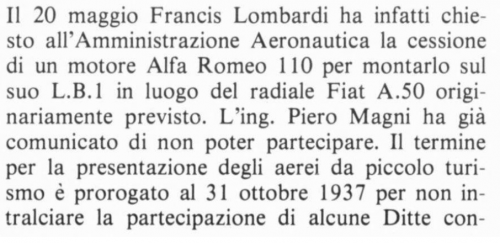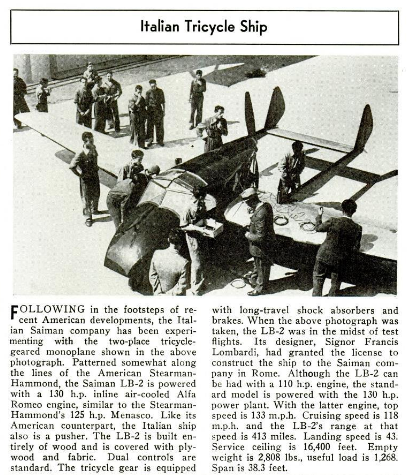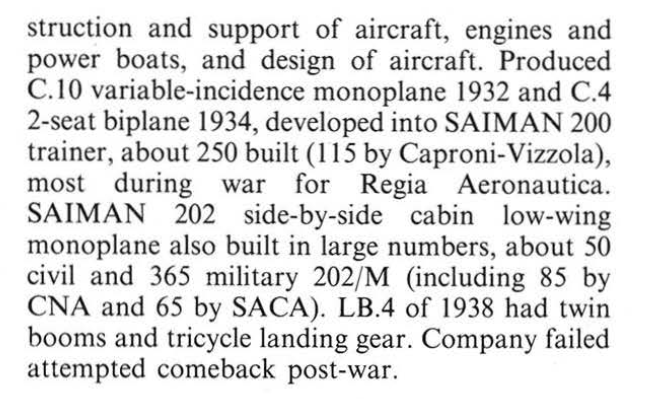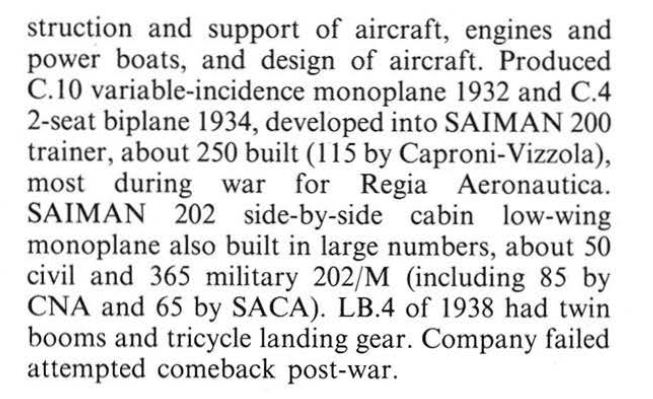- Joined
- 25 July 2007
- Messages
- 4,167
- Reaction score
- 3,835
S.A.I.M.A.N. -- Società Anonima Industrie Meccaniche Aeronautiche Navali
The Società Anonima Industrie Meccaniche Aeronautiche Navali (the Naval Aviation Mechanical Industries Limited Company) was formed at Lido di Roma in 1934.* Part of the Caproni group, S.A.I.M.A.N. (also rendered as SAIMAN, or Saiman) was initially a repair and maintenance facility.
There are some puzzles about SAIMAN production. According to some sources, the first aircraft produced was the 1936 SAIMAN C.4, designed by Ing. E. Cambilargiu. The C.4 was a rally aircraft developed specifically for the Avioraduno Sahariano (Saharan Circuit). The C.4 was a one-off and it seems unlikely that Cambilargiu designed any other aircraft for SAIMAN (I'm attaching the beginnings of a separate Cambilargiu list below the SAIMAN list).
Oft-repeated online references claim SAIMAN's founding to have been in 1929 with aircraft construction beginning "in 1932 with an experimental monoplane, designated C.10, which had a variable-incidence wing." SIRIS also list a "Saiman C.10". There was a Cambilargiu C-10 but that was an incompleted 1924 glider project. Was this 'Saiman C.10' a separate design and, if so, by whom?
SAIMAN's CEO (L'amministratore delegato) was Ing. Guido Sacerdote but there is no indication that this engineer was a design role. The Chief Designer for SAIMAN was Ing Mario Bottini* who had a hand in all other SAIMAN aircraft designs. Bottini had come from Gabardini where he had designed the Lictor series of low-winged light monoplanes (which, it has been claimed, were an influence upon the SAIMAN 202).
SAIMAN Aircraft Designation Style
The first SAIMAN aircraft designs were designated with their designer's initials:
C. --- For designer, Ing. Emanuele Cambilargiu
L.B. - For designers Carlo Francesco 'Francis' Lombardi and Mario Bottini
The second series of SAIMAN aircraft designations were numerical only, beginning with 200. That sequence continues at least to the SAIMAN 208. Then, for no obvious reason, the SAIMAN sequence jumps to 303. It is tempting to suggest that the type designation SAIMAN 303 seemed like a neat follow-on to the SAIMAN 202 it was to replace. But that is purely speculative.
The SAIMAN V.A.L. (for Volo l'Assaltatore Leggero) may have been otherwise undesignated or this light attack aircraft's numerical designation may simply have been lost in time.
Designations are sometimes assigned a prefix, eg: SAIMAN S.202 or even SAIMAN C.202. It is doubtful that this was an official designation style. However, suffixes were applied -- especially to the SAIMAN 202 series. These include:
R -- Raduno (Rally)
RL - Raduno Littorio
I -- [?? Iniziale, Inizio ??] ie: I serie**
M -- Militari (military version)
Other suffixes include 'bis' and 'B'. Presumably, both refer to second variants.
_______________
* Mario Bottini is also listed as the head of SAIMAN's research department. Ing. Bottini began with Giuseppe Gabardini but the latter was not popular among Fascist decision-makers.
**
-- NB: May simply refer to Alfa-Romeo 110 I engine
_______________
The Società Anonima Industrie Meccaniche Aeronautiche Navali (the Naval Aviation Mechanical Industries Limited Company) was formed at Lido di Roma in 1934.* Part of the Caproni group, S.A.I.M.A.N. (also rendered as SAIMAN, or Saiman) was initially a repair and maintenance facility.
There are some puzzles about SAIMAN production. According to some sources, the first aircraft produced was the 1936 SAIMAN C.4, designed by Ing. E. Cambilargiu. The C.4 was a rally aircraft developed specifically for the Avioraduno Sahariano (Saharan Circuit). The C.4 was a one-off and it seems unlikely that Cambilargiu designed any other aircraft for SAIMAN (I'm attaching the beginnings of a separate Cambilargiu list below the SAIMAN list).
Oft-repeated online references claim SAIMAN's founding to have been in 1929 with aircraft construction beginning "in 1932 with an experimental monoplane, designated C.10, which had a variable-incidence wing." SIRIS also list a "Saiman C.10". There was a Cambilargiu C-10 but that was an incompleted 1924 glider project. Was this 'Saiman C.10' a separate design and, if so, by whom?
SAIMAN's CEO (L'amministratore delegato) was Ing. Guido Sacerdote but there is no indication that this engineer was a design role. The Chief Designer for SAIMAN was Ing Mario Bottini* who had a hand in all other SAIMAN aircraft designs. Bottini had come from Gabardini where he had designed the Lictor series of low-winged light monoplanes (which, it has been claimed, were an influence upon the SAIMAN 202).
SAIMAN Aircraft Designation Style
The first SAIMAN aircraft designs were designated with their designer's initials:
C. --- For designer, Ing. Emanuele Cambilargiu
L.B. - For designers Carlo Francesco 'Francis' Lombardi and Mario Bottini
The second series of SAIMAN aircraft designations were numerical only, beginning with 200. That sequence continues at least to the SAIMAN 208. Then, for no obvious reason, the SAIMAN sequence jumps to 303. It is tempting to suggest that the type designation SAIMAN 303 seemed like a neat follow-on to the SAIMAN 202 it was to replace. But that is purely speculative.
The SAIMAN V.A.L. (for Volo l'Assaltatore Leggero) may have been otherwise undesignated or this light attack aircraft's numerical designation may simply have been lost in time.
Designations are sometimes assigned a prefix, eg: SAIMAN S.202 or even SAIMAN C.202. It is doubtful that this was an official designation style. However, suffixes were applied -- especially to the SAIMAN 202 series. These include:
R -- Raduno (Rally)
RL - Raduno Littorio
I -- [?? Iniziale, Inizio ??] ie: I serie**
M -- Militari (military version)
Other suffixes include 'bis' and 'B'. Presumably, both refer to second variants.
_______________
* Mario Bottini is also listed as the head of SAIMAN's research department. Ing. Bottini began with Giuseppe Gabardini but the latter was not popular among Fascist decision-makers.
**
-- NB: May simply refer to Alfa-Romeo 110 I engine
_______________






